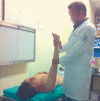Glenoumeral dislocation: a prospective randomized study comparing spazo and kocher maneuvers
- PMID: 26327800
- PMCID: PMC4544527
- DOI: 10.1590/1413-78522015230400701
Glenoumeral dislocation: a prospective randomized study comparing spazo and kocher maneuvers
Abstract
Objective: To evaluate and to compare the Spaso and Kocher reduction maneuvers in terms of efficiency, time of reduction, facileness, pain, discomfort to the patient, complications and risks, besides promoting the comparison between the two maneuvers, aiming to ground the emergency conduct.
Methods: A prospective study with 105 patients with acute shoulder dislocations were enrolled in the study between February 2011 and September 2012. The patients were randomized into two groups and they were submitted to the reduction of dislocation using the Spaso maneuver (group A) or the Kocher technique (group B) by first, second or third-year orthopedic surgery residents from our service. The results were evaluated and compared.
Results: There was no statistically significant difference between the two groups in terms of age, gender, timing of reduction, number of precedent episodes and complications after reduction. However, reduction was achieved in more cases using the Spaso method than it was among the Kocher group, as well as the mean duration of the reduction maneuver and discomfort were shorter in the group A patients.
Conclusions: Both methods presented good results in terms of dislocation reduction and low complications rates. Nevertheless, the Spaso maneuver was more efficient, fast and easily applicable in comparison with Kocher's method. Level of Evidence I, Therapeutic.
Keywords: Manipulation, orthopedic/methods; Prospective studies; Shoulder dislocations; Shoulder joint.
Conflict of interest statement
All the authors declare that there is no potential conflict of interest referring to this article.
Figures









Similar articles
-
Reduction of acute anterior dislocations: a prospective randomized study comparing a new technique with the Hippocratic and Kocher methods.J Bone Joint Surg Am. 2009 Dec;91(12):2775-82. doi: 10.2106/JBJS.H.01434. J Bone Joint Surg Am. 2009. PMID: 19952238 Clinical Trial.
-
Comparison of four different reduction methods for anterior dislocation of the shoulder.J Orthop Surg Res. 2015 May 28;10:80. doi: 10.1186/s13018-015-0226-4. J Orthop Surg Res. 2015. PMID: 26016671 Free PMC article.
-
Teaching Patients How to Reduce a Shoulder Dislocation: A Randomized Clinical Trial Comparing the Boss-Holzach-Matter Self-Assisted Technique and the Spaso Method.J Bone Joint Surg Am. 2018 Mar 7;100(5):375-380. doi: 10.2106/JBJS.17.00687. J Bone Joint Surg Am. 2018. PMID: 29509614 Free PMC article. Clinical Trial.
-
Best evidence topic report. Kocher's or Milch's technique for reduction of anterior shoulder dislocations.Emerg Med J. 2006 Jul;23(7):570-1. doi: 10.1136/emj.2006.038521. Emerg Med J. 2006. PMID: 16794109 Free PMC article. Review.
-
Conservative management following closed reduction of traumatic anterior dislocation of the shoulder.Cochrane Database Syst Rev. 2019 May 10;5(5):CD004962. doi: 10.1002/14651858.CD004962.pub4. Cochrane Database Syst Rev. 2019. PMID: 31074847 Free PMC article.
Cited by
-
Effects of reduction technique for acute anterior shoulder dislocation without sedation or intra-articular pain management: a systematic review and meta-analysis.Eur J Trauma Emerg Surg. 2023 Jun;49(3):1383-1392. doi: 10.1007/s00068-023-02242-8. Epub 2023 Mar 1. Eur J Trauma Emerg Surg. 2023. PMID: 36856781 Free PMC article.
-
Ipsilateral elbow and shoulder dislocations in older people: Which joint should be reduced first?: A rare case report and literature review.Medicine (Baltimore). 2025 Apr 4;104(14):e42080. doi: 10.1097/MD.0000000000042080. Medicine (Baltimore). 2025. PMID: 40193638 Free PMC article. Review.
References
-
- Kocher T. Eine neue Reductions methode fur Srchulter verrenkung. Berliner Kiln Wchnschr. 1870;7:101–105.
-
- Riebel GD, McCabe JB. Anterior shoulder dislocation: a review of reduction techniques. Am J Emerg Med. 1991;9(2):180–188. - PubMed
-
- Uglow MG. Kocher's painless reduction of anterior dislocation of the shoulder: a prospective randomised trial. Injury. 1998;29(2):135–137. - PubMed
-
- Miljesic S, Kelly AM. Reduction of anterior dislocation of the shoulder: the Spaso technique. Emerg Med. 1998;10(3/4):173–175.
-
- Fernández-Valencia JA, Cuñe J, Casulleres JM, Carreño A, Prat S. The Spaso technique: a prospective study of 34 dislocations. Am J Emerg Med. 2009;27(4):466–469. - PubMed
LinkOut - more resources
Full Text Sources
Other Literature Sources
